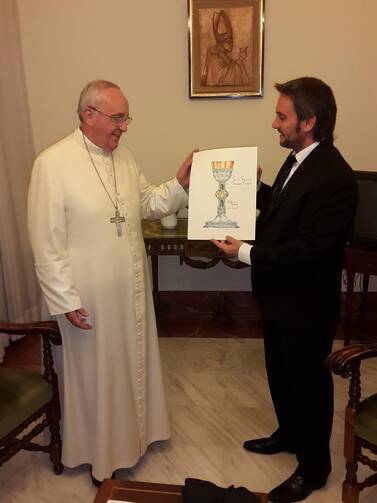In a highly original initiative ahead of Pope Francis’ visit to New York in September, Catholics from across the United States are being given an opportunity to donate small, personal, silver coins or objects that can be used in the making of the chalice that he will use when he celebrates mass in St Patrick’s Cathedral and, maybe at another venue too, during his stay in the city. In this way they can participate in a truly personal way in that event.
The silver that remains from the donations will be sold and the proceeds will be given to the Pope for his work with the poor.
The initiative which is rich in symbolism is the brainchild of Adrian Pallarols, the Argentine gold and silversmith who will actually make the chalice in the basement of St Patrick’s Cathedral in the weeks immediately preceding Francis’ visit. He revealed the project to America’s Vatican correspondent during a recent visit to Rome, and explained how he secured the pope’s blessing for it.
“The idea is to get the greatest number of people to participate in the project by donating small silver objects (metal Ag) that can be melted down into the lingot of silver from which will come the panels that I will use to make the chalice”, he told me. Objects that could be used in the making of the chalice range from coins, rings, earrings, to bracelets, necklaces and the like so long as each one is of this silver standard.
The design for this unique chalice is also the work of Pallarols. He explained that “the design – see photo -recreates the Gothic front of St Patrick’s Cathedral, New York, and also includes a map of the United States that is meant to symbolize the embrace of the Holy Father for all the inhabitants of the United States when he raises the chalice at the consecration during the Eucharistic celebration.” While the exterior of the chalice will be made of the silver that is donated, the inside will be lined with gold out of reverence for the sacred species in which the Lord is present.
This original project integrates well with the history of Saint Patrick’s Cathedral, that is the largest Catholic church in the United States. The cathedral was built thanks to the faith, sacrifice and immense generosity of many thousands of poor Irish immigrants who gave their nickels and dimes for its construction in response to the pressing appeal of the then Archbishop of New York, John Hughes. They were joined by 103 prominent citizens of the city who pledged $1000 each to the building.
Adrian Pallarols came to know the future pope when he was archbishop of Buenos Aires. He recalled that in those early days whenever Cardinal Jorge Bergoglio received gifts made of silver or gold he would phone and ask him to come and take the gifts and sell them, and he would then use the money raised from the sale to help poor people in the Argentine capital. Over the years the silversmith became close to the cardinal, and their relationship continued even after he became Pope.
With this past experience in mind, Pallarols conceived the idea of designing and making a unique and original chalice that Francis would use when he celebrates mass in St Patrick’s Cathedral and possibly also at another venue when he comes to New York. But he immediately linked the making of the chalice to the concomitant project of raising funds for the pope to use for the poor.
The Argentine craftsman hopes that many thousands of Americans will participate in this special venture. He guarantees that all, that is, each and every one of the silver objects donated by Americans will be melted down into the lingot of silver from which the chalice will be made. He expects that a very large quantity of silver will remain after the meltdown, and he plans to sell all that remains and then hand over the money raised to Pope Francis to use as he wishes to help the poor in the United States. A foundation will be created for this purpose.
Once he had come up with the design and the accompanying project, Pallarols took his initiative to Cardinal Timothy Dolan in New York, last January and gained his enthusiastic backing. Then he flew to Rome, presented the design and plan to Pope Francis, and obtained his endorsement too.
The collection will begin next month Pallarols told me. He will be in New York in the coming days to finalize plans for the project which has to be completed in less than six months.








